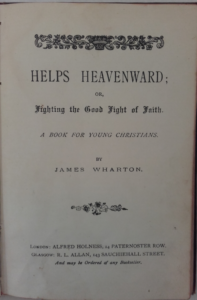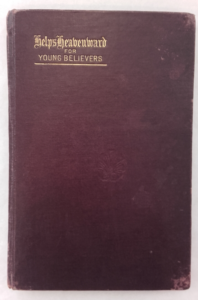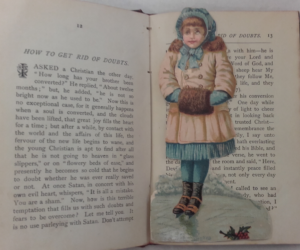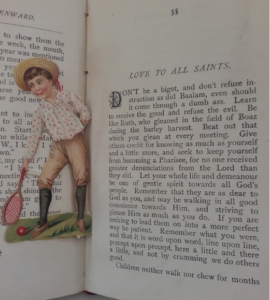In this post, Lyn Wall and Susan Gardner, curators at the Museum of Childhood, share this poignant and touching story which they pieced together from the discovery of a little book in the archive…
One of the great benefits and pleasures of working with the Museum of Childhood book collection is sometimes finding a direct link to the person who owned the book originally, and sometimes we have an insight into an event in their lives, or how they lived their lives.


Whilst working with the SELCIE team we came across a small unassuming hardback book with a plain cover called ‘Helps Heavenward For Young Believers’. On opening the book there was a pencilled inscription as follows: ‘In Memory of My Dear Brother David Stewart Who Died Feb 25 1904 B.S.’

The name David Stewart is not an uncommon one, but even so, we were able to track down what seems to be the correct Stewart family using the 1901 census return, and then found David’s death certificate. The certificate states that he died age 12 at the Infirmary in Edinburgh and the cause of death was ‘pseudo-hypertrophic musc. Paralysis’ (today known as Muscular Dystrophy, a disease where muscles waste away over a period of time), which he had suffered from for a period of 5 years and then for the last 2 months of his life he had tuberculous.
The census shows that David had a sister called Elizabeth, who in 1904 when he died would have been aged 21, and that she was a rubber shoe maker. David was listed as an invalid, and he had two other sisters, Isabella and Margaret. Presumably ‘B.S.’ at the end of the inscription was Elizabeth known as Beth, Betty or Bess?
The date of the inscription and David’s death falls in the middle of the Edwardian era, which in essence hadn’t changed greatly from the late Victorian era in terms of people’s domestic and work experiences. Christianity featured large in most people’s lives at this time, and with high infant mortality rates, and short life spans, it was a comforting thought for most people that their loved ones entered an afterlife. Most people attended church regularly and even if they didn’t they would have been exposed to Christian teachings through their schooling or even work environments.

Our records show that this book was donated by Mrs Pringle of Edinburgh in 1981, but there is nothing to confirm if she was connected to the Stewart family. It wouldn’t be unreasonable to assume there was a family connection, as this is a book which obviously meant a good deal to Elizabeth as she had gone to the effort of writing an inscription in memory of her brother. But sometimes, books and toys of great emotional significance to individuals, end up disconnected in a charity shop or forgotten in an attic or cupboard.
The book instructs the reader in ways they can be better Christians, and how they can use their faith to strengthen their character and hence send them ‘Heavenwards’ through their beliefs and actions in life. The chapter called ‘Growing in Grace’ speaks of a child who lived in a cradle for 29 years: ‘He could neither talk, walk, nor recognise anyone, and was as helpless when he reached manhood as the day he was born’. The reader is then encouraged to ‘grow in grace’ rather than physically grow, by learning to ‘love reading your bible’. The message is — your faith and character make you a strong person, not your physical strength or health. Other chapters guide you on how to rid yourself of doubts about your faith, and how to live a good Christian life.
The Stewart family may have had to draw strength from their faith. David was obviously a poorly child for many years, and they would have known it was unlikely he would reach adulthood. They were not a rich family, living in the Fountainbridge area of Edinburgh, known for its breweries and the site of the North British Rubber Company. The company was established in 1856 alongside the Union Canal and it employed thousands of workers over five generations in manufacturing a variety of products from rubber Wellington boots, pneumatic tyres and hot-water bottles. This is probably where Elizabeth worked. Her father was a lorry driver, who also probably worked for the Rubber Company or one of the breweries. It was a working class and industrial area that by the early twentieth century had declined into slum tenements and generally poor living conditions for the neighbourhood.

Throughout the pages of this book are apparently randomly placed colourful scraps. They do not mark the beginnings of chapters, but it is possible they mark passages of significance to Elizabeth. However, there are also some placed at the back of the book amongst advertisements. It may just have been a way for Elizabeth to keep her scraps safe and flat, or perhaps her brother David had enjoyed playing with or collecting scraps.
Scraps had been mass produced since the early nineteenth century, usually embossed and colourful and cheaply bought, they were accessible to most people. Sometimes they were collected and stuck in books, or used to decorate Valentine or Christmas cards, or even screens. They were extremely popular throughout the Victorian era and well into the twentieth century. They are still made and collected today.


This post written by Lyn and Susan Gardner


